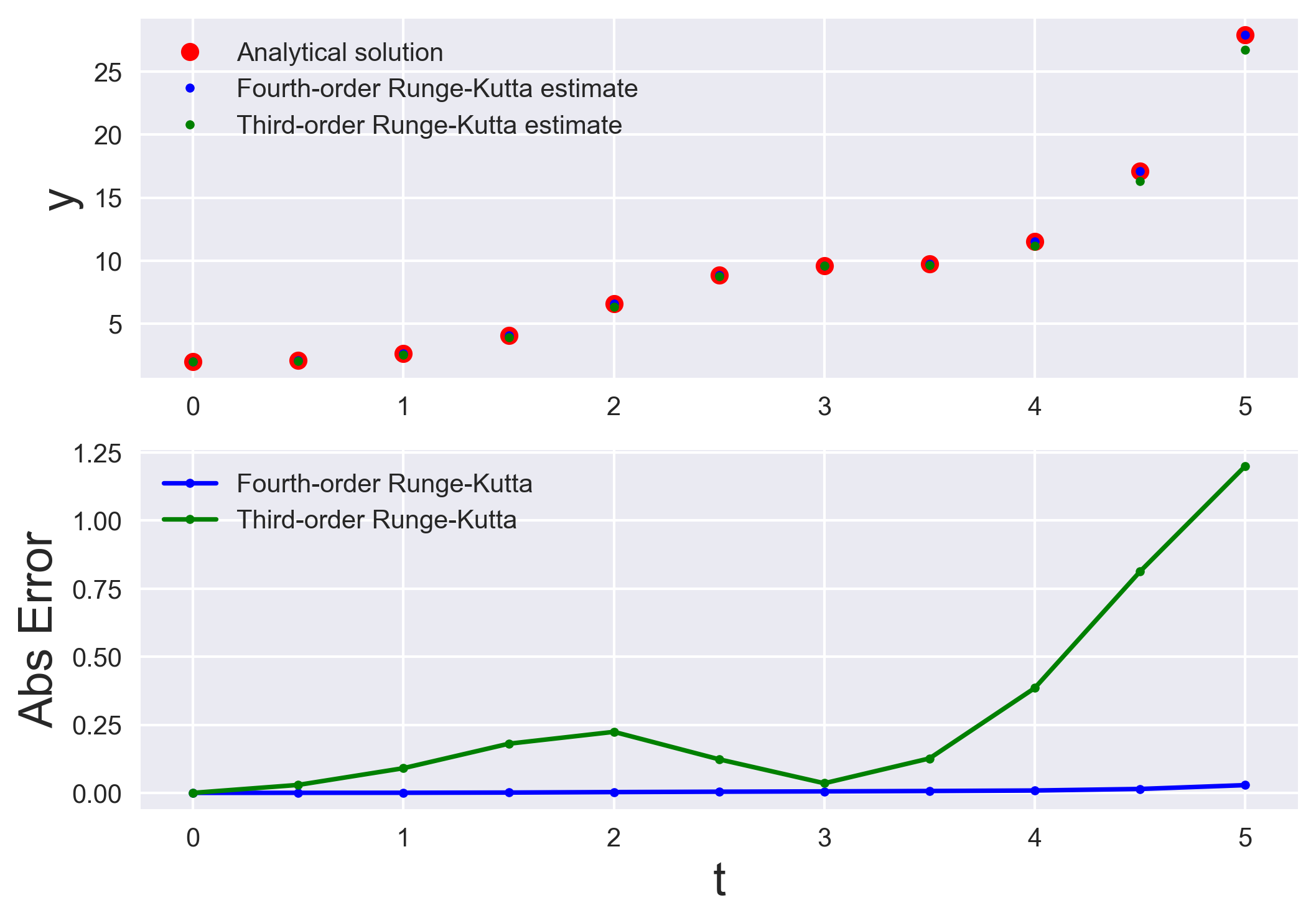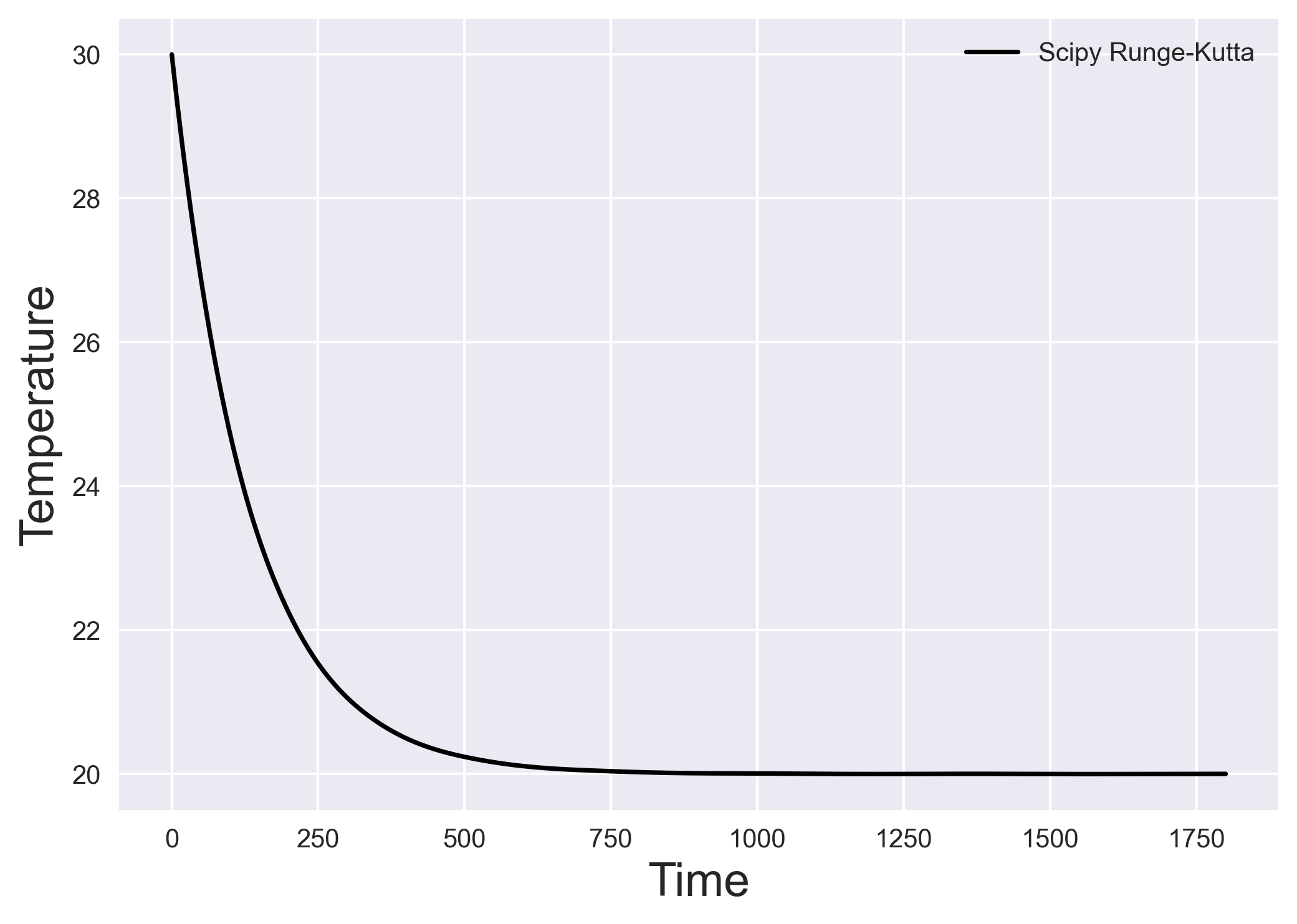Numerically solving initial value problems using the Runge-Kutta method
Runge-Kutta methods are most popular method to solve ordinary differential equations (ODEs) with a better approximation than the Euler method. We compare the third and fourth-order Runge-Kutta estimation with the analytical solution.
In the last post, we discussed about the Euler method to solve the initial value problems. Euler method is simplistic approach for such problems but it comes with large inaccuracy. We will now discuss the Runge-Kutta method for solving such problems.
Runge-Kutta methods
Runge-Kutta methods are used to solve ordinary differential equations (ODEs) with a better approximation than the Euler method. For the Euler method, we ended with an iterative scheme:
\begin{equation} \vec{y}_{n+1} = \vec{y}_n + \Delta t . \phi \end{equation}
where the function \(\phi\) is chosen to reduce the error over a single time-step, \(\Delta t\). For the Runge-Kutta methods, we no longer have to constrain the function \(\phi\) to make use of the derivative at the left end point of the computational step. We also compute the derivative at the midpoint and at the right end of the time-step to possibly improve the accuracy.
In theory, the Euler method is the first-order Runge Kutta method. Heun’s, midpoint, and Ralston method is the second-order Runge Kutta method that uses two derivatives.
Similar posts
Third-order Runge-Kutta
For an ODE: \begin{equation} \frac{d\vec{y}}{dt} = f(t,\vec{y}) \end{equation} where, at \(t=t_0\), \(\vec{y}(0) = \vec{y}_0\). In this post, we assume \(h = \Delta t\). The iterative scheme for the third-order Runge Kutta is:
\begin{equation} \vec{y}_{n+1} = \vec{y}_n + (1/6)h . (k_1 + 4 k_2 + k_3) \end{equation}
where, \begin{equation} k_1 = f(t,\vec{y}) \end{equation}
\begin{equation} k_2 = f(t+h/2,\vec{y}+(h/2).k_1) \end{equation}
\begin{equation} k_3 = f(t+h/2,\vec{y}+h.(-k_1 + 2k_2)) \end{equation}
Fourth-order Runge-Kutta
The most popular general stepping scheme used in practice is the fourth-order Runge Kutta method. In this case, the Taylor series local truncation error is pushed to \(O(\Delta t^5)\), and the total cumulative error becomes \(O(\Delta t^4)\). Hence, the name “fourth-order”.
For an ODE:
\begin{equation} \frac{d\vec{y}}{dt} = f(t,\vec{y}) \end{equation}
where, at \(t=t_0\), \(\vec{y}(0) = \vec{y}_0\). The iterative scheme for the fourth-order Runge Kutta is:
\begin{equation} \vec{y}_{n+1} = \vec{y}_n + h . T_4(t,\vec{y},h) \end{equation}
Here, \(T_4\) is \begin{equation} T_4 = \frac{1}{6}(k_1 + 2k_2 + 2k_3 + k_4) \end{equation}
\begin{equation} k_1 = f(t,\vec{y}) \end{equation}
\begin{equation} k_2 = f(t+h/2,\vec{y}+(h/2).k_1) \end{equation}
\begin{equation} k_3 = f(t+h/2,\vec{y}+(h/2).k_2) \end{equation}
\begin{equation} k_4 = f(t+h,\vec{y}+h.k_3) \end{equation}
Example problem
\begin{equation} \frac{dy}{dt} = sin(t)^2 * y \end{equation}
where, the initial conditions are \(t(0)=1\), and \(y(0)=2\). We can use the step size of \(h=0.5\).
Here, the general solution of this differential equation is:
\begin{equation} y = 2 e^{0.5*(t-sin(t)cos(t))} + c \end{equation}
Solving Example problem using Python
We can solve the ODE using the third and fourth-order Runge-Kutta method and compare the estimation with the analytical solution.
import numpy as np
import matplotlib.pyplot as plt
plt.style.use('seaborn')
# define equations
def dydt(t, y): return np.sin(t)**2*y
def f(t): return 2*np.exp(0.5*(t-np.sin(t)*np.cos(t)))
def RK3(t, y, h):
# compute approximations
k_1 = dydt(t, y)
k_2 = dydt(t+h/2, y+(h/2)*k_1)
k_3 = dydt(t+h/2, y+h*(-k_1 + 2*k_2))
# calculate new y estimate
y = y + h * (1/6) * (k_1 + 4 * k_2 + k_3)
return y
def RK4(t, y, h):
# compute approximations
k_1 = dydt(t, y)
k_2 = dydt(t+h/2, y+(h/2)*k_1)
k_3 = dydt(t+h/2, y+(h/2)*k_2)
k_4 = dydt(t+h, y+h*k_3)
# calculate new y estimate
y = y + h * (1/6)*(k_1 + 2*k_2 + 2*k_3 + k_4)
return y
# Initialization
ti = 0
tf = 5
h = 0.5
n = int((tf-ti)/h)
t = 0
y = 2
y_rk3 = 2
print("t \t\t yRK3 \t\t yRK4 \t\t f(t)")
print(f"{t:.1f} \t\t {y_rk3:4f} \t\t {y:4f} \t\t {f(t):.4f}")
t_plot = []
y_RK3 = []
y_RK4 = []
y_analytical = []
##
for i in range(1, n+1):
t_plot.append(t)
y_RK4.append(y)
y_RK3.append(y_rk3)
y_analytical.append(f(t))
# calculate new y estimate
y = RK4(t, y, h)
y_rk3 = RK3(t, y_rk3, h)
t += h
print(f"{t:.1f} \t\t {y_rk3:4f} \t\t {y:4f} \t\t {f(t):.4f}")
t_plot.append(t)
y_RK3.append(y_rk3)
y_RK4.append(y)
y_analytical.append(f(t))
# Visualization
fig, (ax, ax2) = plt.subplots(2, 1)
ax.plot(t_plot, y_analytical, 'ro', label='Analytical solution')
ax.plot(t_plot, y_RK4, '.b', label='Fourth-order Runge-Kutta estimate')
ax.plot(t_plot, y_RK3, '.g', label='Third-order Runge-Kutta estimate')
ax.set_ylabel("y", fontsize=18)
ax.legend()
ax2.plot(t_plot, np.abs(np.array(y_analytical) -
np.array(y_RK4)), '.-b', label='Fourth-order Runge-Kutta')
ax2.plot(t_plot, np.abs(np.array(y_analytical) -
np.array(y_RK3)), '.-g', label='Third-order Runge-Kutta')
ax2.set_ylabel("Abs Error", fontsize=18)
ax2.legend()
ax2.set_xlabel("t", fontsize=18)
plt.savefig('runge_kutta_analytical.png', dpi=300, bbox_inches='tight')
t yRK3 yRK4 f(t)
0.0 2.000000 2.000000 2.0000
0.5 2.051632 2.080616 2.0809
1.0 2.536277 2.626551 2.6269
1.5 3.906789 4.086093 4.0872
2.0 6.344784 6.566018 6.5689
2.5 8.748588 8.867524 8.8718
3.0 9.576568 9.606408 9.6119
3.5 9.639375 9.759067 9.7659
4.0 11.154816 11.531199 11.5399
4.5 16.305226 17.103444 17.1178
5.0 26.714744 27.886259 27.9147

Heat transfer problem using fourth-order Runge Kutta
We can solve the heat transfer problem from the previous post using the scipy’s scipy.integrate.solve_ivp function. It uses explicit Runge-Kutta method of order 5. The error is controlled assuming accuracy of the fourth-order method, but steps are taken using the fifth-order accurate formula (local extrapolation is done).
For the heat transfer problem, We find the temperature profile of an object in contact with a constant temperature surface through a thermal conductance.
\begin{equation} \frac{dT}{dt} = -\frac{k}{c} (T-T_f) \end{equation}
where \(T_f\) is the constant temperature of the surface, \(k\) is the thermal conductance, \(c\) is the specific heat of the object, and \(T\) is the variable temperature of the object. Here, we know the temperature of the object at \(t=0\).
\begin{equation} T(0) = 30 \end{equation}
import numpy as np
import matplotlib.pyplot as plt
from scipy.integrate import solve_ivp
plt.style.use('seaborn')
# the governing equation
def heat_equations(t, T):
k = 0.075
C = 10
T_f = 20
return -k * (T - T_f) / C
# Time steps
teval = np.linspace(0, 1800, 1000)
# ivp solver: Runge-Kutta
sol = solve_ivp(heat_equations, (teval[0], teval[-1]), (30,), t_eval=teval)
fig, ax = plt.subplots()
ax.plot(sol.t, sol.y[0, :], "-k", ms=3, label='Scipy Runge-Kutta')
ax.set_ylabel("Temperature", fontsize=18)
ax.set_xlabel("Time", fontsize=18)
plt.legend()
plt.savefig('runge_kutta_heat_transfer_sol.png', dpi=300, bbox_inches='tight')

References
- Kutz, J. N. (2013). Data-driven modeling & scientific computation: methods for complex systems & big data. Oxford University Press.
Disclaimer of liability
The information provided by the Earth Inversion is made available for educational purposes only.
Whilst we endeavor to keep the information up-to-date and correct. Earth Inversion makes no representations or warranties of any kind, express or implied about the completeness, accuracy, reliability, suitability or availability with respect to the website or the information, products, services or related graphics content on the website for any purpose.
UNDER NO CIRCUMSTANCE SHALL WE HAVE ANY LIABILITY TO YOU FOR ANY LOSS OR DAMAGE OF ANY KIND INCURRED AS A RESULT OF THE USE OF THE SITE OR RELIANCE ON ANY INFORMATION PROVIDED ON THE SITE. ANY RELIANCE YOU PLACED ON SUCH MATERIAL IS THEREFORE STRICTLY AT YOUR OWN RISK.

Leave a comment